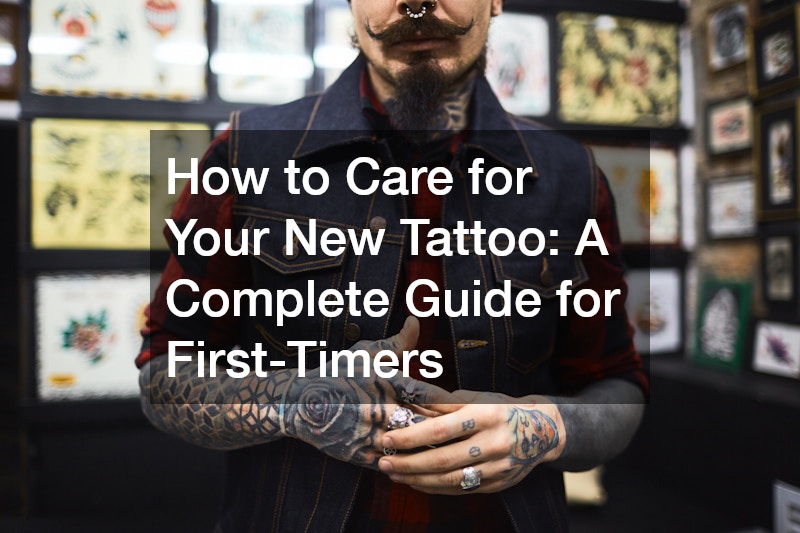
Getting a tattoo can be an exciting and deeply personal experience. Whether it’s your first time or you’re adding to a growing collection, the thrill of getting a new piece is unmatched. However, it’s important to remember that proper aftercare is essential to ensure that it heals well and looks its best for years to come. This comprehensive guide will provide first-timers with the necessary knowledge to take care of their new piece from the moment it’s inked until it’s fully healed, and beyond.
Your skin undergoes a natural healing process that involves various stages. The first stage is when the skin is raw and needs to be kept clean to prevent infection. The second stage involves the scabbing and peeling process, where dead skin cells are shed, and the skin starts to repair itself. During this time, taking care of your skin is crucial to ensure it heals correctly. A good aftercare routine helps maintain the design’s integrity, avoiding any distortion or fading. Additionally, aftercare is not just about the initial healing period—it’s also about long-term tattoo care to keep your ink looking sharp and your skin healthy.
The Healing Process: Understanding the Stages

Getting a tattoo is essentially having many tiny open wounds that require proper care to prevent infection and promote healing. The artist uses needles to inject ink into the dermis, the layer of skin beneath the outermost layer, causing tiny injuries to the skin. Once completed, the healing process begins. The skin needs time to recover, typically around two to three weeks for the initial healing, with full recovery taking up to six months. During this time, keeping the area clean and moisturized is crucial to prevent irritation and preserve the vibrant colors of the design. Proper care during this time will ensure the best possible outcome.
For first-timers, it’s essential to be mindful of healing and its various stages. In the first few days, the area will be covered in a thin layer of ointment and wrapped in plastic. Once you remove the wrap, you should begin cleaning your tattoo with gentle cleansers. This helps remove any bacteria and dirt that may have accumulated. As the healing process progresses, you’ll notice scabs will start to appear and the skin will begin to peel. This stage is delicate, and it’s important not to pick at the scabs or scratch the skin to avoid disturbing the ink.
Aftercare Basics: What to Expect and Why It’s Important
In the first 24 to 48 hours, it is critical to follow the aftercare instructions given by your artist. The tattoo will be covered to protect it from bacteria and dirt, but once the bandage is removed, the real aftercare begins. You will need to clean the area with mild soap and warm water, followed by applying a thin layer of healing ointment. This helps to keep the skin moisturized while the healing process begins. Not using the proper care techniques during these early hours can result in infections, fading, or even permanent scarring.
As part of your long-term tattoo care, you’ll need to continue moisturizing for several weeks. Once the initial healing is complete, your skin will start to peel. This is when proper care becomes even more important. You should never scratch or pick, as this can cause scarring and damage the design. Additionally, during the first few weeks, avoid direct exposure to sunlight, as UV rays can cause the ink to fade prematurely. Regular moisturizing with a tattoo-friendly lotion and following your artist’s advice on aftercare will keep your piece looking vibrant for years to come.
Aftercare: Best Practices for Tattooed Skin
Aftercare goes hand-in-hand with general skin care. Your skin’s health is directly related to how well your tattoo heals and how vibrant it looks in the long run. Your skin is essentially compromised, and the body’s natural healing process is activated. Keeping the tattooed area clean, moisturized, and protected is essential. These products are often formulated with natural ingredients that help soothe the skin without causing irritation or interfering with the healing process.
For long-term tattoo care, using a fragrance-free moisturizer once it has fully healed can help maintain skin hydration and prevent dryness. Tattooed skin tends to be more sensitive, so be mindful of using products that might irritate or clog your pores. Skin products that are designed for tattoos, such as aftercare creams and balms, are highly recommended. Regularly moisturizing the area will keep the skin supple and smooth, preventing it from becoming too dry or cracked. Additionally, using a foam cleanser can aid in gently washing without causing damage to the skin, keeping the design intact and clear from infection-causing bacteria.
How to Clean Your New Piece: Choosing the Right Cleansers and Tools

Cleaning your new piece is one of the most important aspects of the aftercare process. Proper cleaning removes dirt, sweat, and bacteria that can cause infections or disrupt the healing process. When cleaning your tattoo, it’s essential to use only gentle, unscented cleansers specifically designed for sensitive situations. Using medical grade foam cleansers can help maintain the skin’s integrity by providing a mild yet effective cleansing option. These foams are gentle on the skin, and their non-abrasive nature prevents over-scrubbing, which could potentially harm your skin. Harsh soaps or chemicals can strip away the natural oils of the skin and irritate the tattoo, leading to unnecessary complications.
Aside from the right cleaners, it’s important to use properly sterilized items, such as gauze or a soft towel, to gently pat the area dry. Avoid rubbing the tattooed area, as this can lead to irritation or premature removal of scabs. After cleaning, a thin layer of ointment or a light moisturizer should be applied to lock in moisture and protect the piece as it heals. Remember to clean your new piece only twice a day to avoid over-washing, which could dry out your skin. Following these cleaning guidelines ensures your tattoo heals well and maintains its sharpness over time.
Removing Hair: The Role of Hair Around Tattooed Skin
Hair removal near the tattooed area plays a role in both the initial and long-term care of your ink. Shaving or waxing near a fresh tattoo can lead to irritation, ingrown hairs, or even an increased risk of infection if the area is not properly sanitized. It’s important to avoid removing hair with procedures like waxing or using razors directly on or near the tattooed area until the skin has fully healed. Even once healed, you should be gentle when shaving over the tattooed skin to prevent disturbing the design or causing scarring.
As part of long-term tattoo care, it’s advisable to keep hair away from the tattooed area without directly affecting the ink. Using an electric trimmer is a gentler way to remove unwanted hair around the area without causing irritation. If you are undergoing removal procedures such as laser removal for hair, always consult with your professional artist first to ensure that the procedure won’t damage your new piece.
When to Seek Professional Help: Doctors and Experts
It’s essential to know when to seek professional help during the tattoo healing process. If you notice any signs of infection, such as excessive redness, swelling, pus, or unusual pain, you should immediately consult a family doctor. Infections can spread quickly, and prompt treatment can prevent permanent damage to your tattoo and skin. Additionally, if you are unsure about whether you should apply certain products to your tattoo, consult your tattoo artist or a professional to receive guidance on proper aftercare. Your tattoo artist is a valuable resource in offering professional advice about healing and ensuring that your tattoo heals correctly.
If you’re unsure about how your tattoo is healing, don’t hesitate to reach out to the tattoo shop for a follow-up consultation. Tattoo artists are trained to spot signs of infection, poor healing, or any other complications that may arise during the process. Following the aftercare guidelines given by professionals ensures the best possible outcome, and they can provide guidance tailored to your specific tattoo style and skin type.
Protecting Your Artwork: Treatments, Sun Exposure, and External Factors

Once your tattoo has healed, protecting it from external elements is key to maintaining its vibrancy. Exposure to UV rays is one of the biggest threats to the longevity of a tattoo. The sun’s UV rays can cause fading and even break down the ink over time. Always apply sunscreen to your tattoo whenever it’s exposed to direct sunlight. Additionally, while getting a facial is a great way to care for your skin, avoid exfoliating the tattooed area, as this can remove the ink along with dead skin cells. It’s important to maintain a gentle skin routine that doesn’t disrupt the healing tattoo.
For long-term tattoo care, sun protection becomes a vital part of preserving your tattoo’s colors. Tattooed skin tends to be more sensitive to sun exposure, so using sunscreen with a high SPF on your tattoo is a must. Additionally, treatments like chemical peels or exfoliation should be done cautiously around the tattoo. Always inform the esthetician about your tattoo and its location, so they can avoid causing damage during any treatment. Keeping your tattoo shielded from the sun and harsh treatments will help maintain its vibrant appearance.
Aftercare Long-Term: Maintaining Your Ink for Years
Long-term tattoo care is crucial for keeping your tattoo looking its best over the years. After the initial healing process, your tattoo may appear healed, but that doesn’t mean you should stop caring for it. It’s essential to continue moisturizing the area to prevent the skin from becoming dry, which can cause the tattoo to fade. Using a tattoo-friendly moisturizer or balm that’s designed for long-term skin hydration helps maintain the vibrancy of the tattoo’s colors. Regular practices in your skin routine, such as exfoliating the skin around the tattoo and applying sunscreen, will prevent the tattoo from aging prematurely.
The use of sunscreen in long-term tattoo care cannot be overstated. Protecting your tattoo from UV rays by applying sunscreen will prevent the fading of colors and keep your skin healthy. Another tip is to avoid extreme temperature changes, such as very hot showers or saunas, which can cause the skin to stretch and affect the tattoo’s quality. By following these long-term care tips and being mindful of your skin’s health, your tattoo will remain a beautiful work of art for years to come.
Common Mistakes: What to Avoid in Ink Aftercare
While tattoo aftercare seems straightforward, many first-timers make mistakes that can compromise their tattoo’s healing process. One common mistake is over-washing the tattoo or using harsh soaps and chemicals that irritate the skin. It’s important to use a gentle, tattoo-friendly cleaner and avoid scrubbing the tattoo too hard. Another mistake is not allowing the tattoo to breathe. Covering it with too many layers of ointment or applying tight clothing can trap moisture and cause irritation. Picking at scabs or peeling skin can also result in faded pieces or scarring, so it’s essential to let the skin shed naturally.
For long-term tattoo care, it’s important to avoid exposing your tattoo to harsh elements like UV rays, chlorinated pools, or saltwater for extended periods. In the same way, you should steer clear of excessive scrubbing or exfoliating the tattooed skin. By maintaining a consistent aftercare routine and steering clear of these mistakes, you’ll help your tattoo stay vibrant and intact for years to come.
Professional Tools: Recognizing an Artist’s Sterile Set-up

Ensuring tattoo artists use sterile equipment is crucial for both safety and tattoo quality. Tattooing involves puncturing the skin, which can expose you to bacteria and infections if proper hygiene isn’t followed. Artists prevent this by using sterile needles, grips, and tubes, and by disposing of single-use items like gloves and razors after each session.
Reputable artists always open new sterile needles and ink containers in front of clients, ensuring everything is clean. Non-disposable tools should be sanitized properly, typically through autoclaving. Always feel free to ask your artist about their sterilization practices—if the environment seems questionable, it may be a red flag. Using sterile tools helps your tattoo heal well and maintain its vibrancy in the long run.
Caring for your new tattoo is essential for ensuring that it heals properly and remains vibrant for a lifetime. The tattoo healing process requires attention to detail, patience, and commitment to proper care, cleaning, and moisturizing. By following the steps outlined in this guide and incorporating long-term tattoo care into your routine, you’ll ensure that your tattoo stays fresh and bold. Remember, your tattoo is a permanent piece of art on your skin, and it deserves the best care. Always consult your tattoo artist or a professional if you have any concerns, and be sure to protect your tattoo from harsh environments. With the right approach, your tattoo will remain a source of pride for many years to come.


